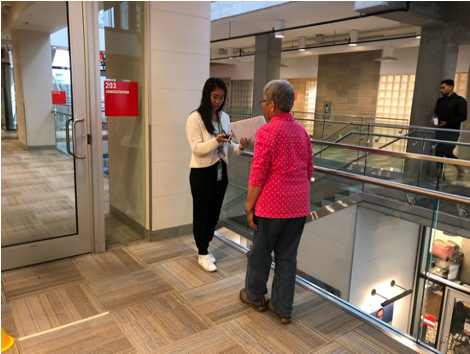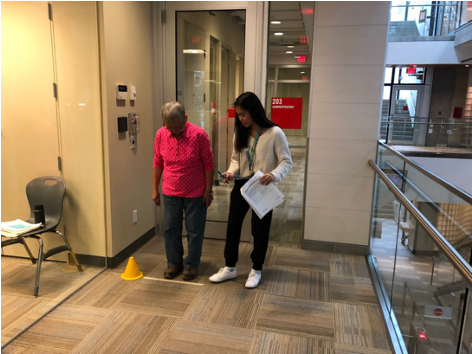By: Johanna Dingle
As life expectancy gradually increases, a question to ask is, “whether the added time comprises years of healthy life and promotes a high health-related quality of life into old age” (Langhammer et al., 2018, p. 1). Throughout my undergrad as a health sciences student, my professors and the curriculum often emphasized the topic of older adult health and the societal implications of this growing demographic in Canada. This subject resonated with me and piqued my interest in geriatric health. I believe that everyone should be able to access healthcare to help them lead healthy lives. If at a population level, we choose health-promoting behaviours, we can avoid overburdening our health-care system and live healthier lives.
During my co-op placement with UBC’s Active Aging Research Team, I had the opportunity to work and contribute to research that focuses on older adult health. My role as a research assistant on the Choose to Move evaluation team allowed me to observe the importance preventative measures, like physical activity and social connection, among seniors, have in supporting and enhancing quality of life, longevity and independence.
CHOOSE TO MOVE
Choose to Move is a province-wide evidence-based intervention that promotes physical activity (PA) and social connectedness among inactive people aged 65 and older. Participants meet with an activity coach and choose activities of interest to accomplish their goals. With the help of the activity coach, participants create a PA plan and stay accountable through telephone check-ins. Although Choose to Move is not an exercise class, activity coaches lead group meetings at which participants learn about various health topics, receive take-home exercises, and have the opportunity to connect with other participants by sharing their achievements and challenges. With the support and funding of the Government of British Columbia (BC), Choose to Move is delivered across BC through a partnership with the Active Aging Society, YMCA, British Columbia Recreation and Parks Association and many other community organizations.
THE ROLE OF CHOOSE TO MOVE IN CHRONIC DISEASE PREVENTION
One of the most significant realizations I had while working with the Active Aging Research Team was the importance of implementing health promotion strategies. It struck me that, though finding treatments for diseases is essential, it is imperative that we focus on preventing future health concerns. As the average lifespan increases and the population ages, it is critical that we expand the period of ‘healthy life years’ (Rechel et al., 2013, as cited by McPhee et al., 2016, p. 568). Maintaining mobility indicates a greater chance of retaining independence (Heikkinen et al., 1998). It is important to note that, “PA and mobility are closely linked thus, PA prevention strategies that contribute to older adult mobility are key to diminish the risk of chronic diseases, preserve older adults’ independence and curb escalating healthcare costs” (McKay et al., 2018, p. 976). Regular PA is beneficial and safe to practice among healthy and frail older adults (McPhee et al., 2016).
Choose to Move aims to increase social connections and physical activity, which can improve mental health, reduce symptoms of depression and anxiety (Bauman et al., 2016), decrease feelings of loneliness (Ashida et al., 2018), delay the onset of dementia (Livingston et al., 2017, as cited by Langhammer et al., 2018), ultimately promoting improved wellbeing and quality of life (Camboim et al., 2017, Das and Horton, 2012, as cited by Langhammer et al., 2018). The implementation of scheduled regular physical activity helps decrease the risk of developing osteoporosis, muscle weakness, and other chronic problems such as cardiovascular and metabolic diseases. (McPhee et al., 2016). All factors contribute to a healthy lifestyle, better wellbeing and longevity.


These photos were taken at an evaluation site where I conducted physical measurements with a participant.
TAKEAWAYS
Through this role, I was able to recognize my own ageist beliefs. I underestimated the abilities of older adults. I have come to realize just how strong, mobile and capable many older adults can be. This co-op experience has given me the opportunity to listen to seniors and understand that they face discrimination and stereotyping. I have gained a new perspective, and I am grateful.
A key takeaway for me was that we must focus on chronic disease prevention strategies, such as supporting people to be physically active and socially connected. I witnessed the positive impact of this among the Choose to Move participants that I met. I am privileged to have had the opportunity to learn, share my knowledge, and work with a team that is improving the health and quality of life for seniors. I hope to carry all of my learnings and experience with me as I continue to pursue a career in health. After working with UBC’s Active Aging Research Team, I feel motivated to continue to advocate for and promote the health of older adults in our communities.
References
1. Ashida, S., Sewell, DK, Schafer, EJ, et al. (2018) Social network members who engage in activities with older adults: Do they bring more social benefits than other members? Ageing and Society 39(5): 1050-1069. doi:10.1017/s0144686x17001490
2. Bauman, A, Merom, D, Bull, FC, et al. (2016) Updating the evidence for physical activity: Summative reviews of the epidemiological evidence, prevalence, and interventions to promote “Active Aging”. The Gerontologist 56 (Suppl 2): S268-S280. doi:10.1093/geront/gnw031
3. Camboim, FEF, Nóbrega, MO, Davim, RMB et al. (2017). Benefits of physical activity in the third age for the quality of life. Journal of Nursing UFPE/Revista de Enfermagem UFPE, 11(6), 2415-2422, doi:10.5205/reuol.10827-96111-1-ED.1106201721
4. Das, P, & Horton, R. (2012). Rethinking our approach to physical activity. The Lancet (British Edition), 380(9838), 189-190. doi:10.1016/S0140-6736(12)61024-1
5. Heikkinen, RL & World Health Organization Ageing and Health Programme. (1998). Growing older – staying well: Ageing and physical activity in everyday life. Geneva, Switzerland: World Health Organization. Available at: https://apps.who.int/iris/handle/10665/65230 (accessed July 2020).
6. Langhammer, B, Bergland, A, & Rydwik, E. (2018) The Importance of physical activity exercise among older people. BioMed Research International 2018: 1-3. doi:10.1155/2018/7856823
7. Livingston, G, Sommerlad, A, Orgeta, V, et al. (2017). Dementia prevention, intervention, and care. The Lancet (British Edition), 390(10113), 2673-2734. doi:10.1016/S0140-6736(17)31363-6
8. Mckay, HA, Nettlefold, L, Hoy, C, et al. (2018) Bright spots, physical activity investments that work: Scaling up a physical activity model for older adults. British Journal of Sports Medicine 53(15): 976-977. doi:10.1136/bjsports-2017-098990
9. Mcphee, JS, French, D., Jackson, D, et al. (2016) Physical activity in older age: Perspectives for healthy ageing and frailty. Biogerontology 17(3): 567-580. doi:10.1007/s10522-016-9641-0
10. Rechel, B, Grundy, E, Robine, JM, et al. (2013) Ageing in the European union. The Lancet (British Edition), 381(9874), 1312-1322. doi:10.1016/S0140-6736(12)62087-X

